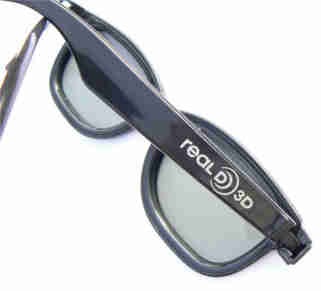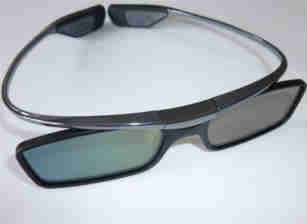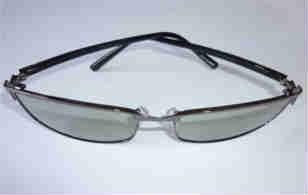IN DEPTH Pros and cons of Active Shutter and Passive 3D TV
If you're looking to buy a 3D TV, making that big decision is a good deal more complicated than it was this time last year. That's because there are now two competing 3D technologies which do the same job: Active Shutter and Passive Polarisation. But how do they compare and which 3D tech will work best for you?
Here we weigh up the pros and cons of Active Shutter vs Passive 3D TV.
Active Shutter 3D: How it works, pros and cons
Active Shutter technology is exclusively supported by Panasonic, Samsung and Sony. All offer a wide range of screen sizes designed to work with Active Shutter glasses.
Powered by a small battery, these glasses incorporate LCD lenses which sync to alternating frames on the TV. The system can deliver a Full HD 1080p image to each eye – hence the description Full HD 3D.
While some TVs come bundled with these Active 3D goggles, many compatible sets now require you to invest in them as an optional accessory – and they're not cheap.

Figure 1 – Active Shutter spex may be getting lighter, but they remain prohibitively expensive. Notice how it's impossible to make Active Shutter lenses with a curve
Typically Active Shutter glasses sell for around 100 dollars a pair, if not more. They're fragile, and to complicate matters further, one brand of glasses will not work with another's TV. So if you have a Samsung 3D TV, you'll need Samsung 3D bins.
A belated attempt to unify the Active Shutter glasses standard by Panasonic does not seem to gaining much traction.
Passive Polarisation 3D: How it works, pros and cons
Passive 3D technology has been developed and championed by LG. Rather than throw the emphasis on high-tech glasses, passive 3D TV screens sport a filter with alternating horizontal and vertical stripes, separated by a black, picture-blanking bars.
When used with glasses which have corresponding polarising lenses, alternate frames are presented to each eye to create a 3D image.

Figure 2 – Lightweight passive 3D glasses will not break the bank. You can even use 3D glasses "borrowed" from your local cinema
Crucially, Passive 3D glasses are inexpensive. You can even watch Passive 3D TVs at home with the same 3D glasses used in most cinemas (hence LG's 'Cinema 3D' branding). One brand's passive glasses will work with another's; they're interchangeable.
Passive 3D glasses are also comparatively light and comfortable. Indeed, some spectacle makers now offer designer 3D glasses that appear indistinguishable from regular sunglasses. They can even be worn outside, as they offer UV protection.

Figure 3 – These designer Passive 3D glasses can also double as regular sunglasses and offer UV protection. Note the high quality curved lenses
The catch with Passive 3D is that the system reduces the resolution of the 3D image. A Full HD 3D 1920 x 1080 Blu-ray is presented at 1920 x 540 pixels; Sky 3D, which transmits in a 1920 x 540 resolution side-by-side format, is delivered at 960 x 540.
Active Shutter Vs Passive 3D: Screen comparisons
When directly compared, Active Shutter 3D delivers the sharpest, smoothest 3D experience. Its advantages are most notable on curving and diagonal edges.
The black bars which break the horizontal and vertical stripes on the Passive filter can create stepping effects in an image which are easily visible. Indeed, the reduced horizontal resolution of the Passive 3D system has a screen texture that looks remarkably similar to a cathode ray tube TV of yesteryear.
However, while edges are jaggy, there is no diminishment of 3D depth. Passive 3D TVs look just as three dimensional as their Active Shutter counterparts.
Unfortunately, while Active Shutter glasses may offer smoother, richer 3D, they can also suffer from flicker. Some wearers subliminally notice the 60Hz frame refresh rate of the flickering LCDs, while others are aware of flicker created by conflicting light sources.
The glasses also tend to be cumbersome – although we have recently seen brands like Samsung introduce a new generation of lightweight Active Shutter spex.

Figure 4 – Active Shutter 3D Tvs have superior resolution and edge smoothness. Consider the summerhouse from early in Monsters Vs Aliens...

Figure 5 – Closing in, look at the smoothness of the sloping roof, the unbroken outline of the girl, and the fine detail in the balustrade fence design

Figure 6 – This is the same frame, as seen on a Passive 3D TV. Notice how the preponderance of black lines dulls the white dress of the girl

Figure 7 – In passive 3D, the image becomes much courser. The black lines which separate the horizontal and vertical polarising strips on the filter create uneven jagged edges

Figure 8 – The low horizontal resolution of the Passive 3D display can be seen across this shot

Figure 9 – With an Active Shutter 3D TV, there is no loss of horizontal resolution. Edges are smooth and textures are accurate
Active Shutter Vs Passive 3D: Conclusion and costs
So should you buy Active Shutter 3D or Passive 3D? Ultimately it's a personal decision, and one you should only make after auditioning your preferred screen/s in the flesh. (NB other factors may well influence your buying decision anyway, as there's more to TVs than just 3D, after all).
Consider carefully what kind of material you'll be watching in 3D – will it be primarily kiddie fare or more critically demanding material such as sports?
In our tests, Active Shutter 3D consistently offers the highest picture quality. But Passive's lack of clarity must be balanced against the practicality of its inexpensive eyeware. LG is currently shipping seven pairs of 3D glasses with all Cinema 3D TVs, more than enough for family and visiting friends.
The best value deals are also likely to come from the Passive camp. Both Toshiba and Philips plan on positioning their Passive 3D TVs at entry and mid-market price points, reserving Active Shutter for their more expensive, high-end screens.
If you're still unsure, mull over these three simple rules:
Buy a Passive 3D TV if…
You mainly intend on watching 3D animation movies with your kids.
You want to host 3D sports parties and invite your mates.
If you intend to buy a relatively small 3D TV (42 inches or less).
Buy an Active Shutter 3D TV if…
You're a film fan who wants to see movies in the highest possible resolution.
If you plan on kicking back and watching sports on your own.
If you plan on buying a large screen 3D TV (46 inches or bigger).